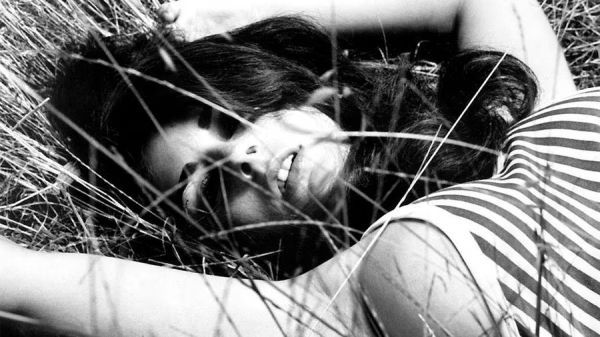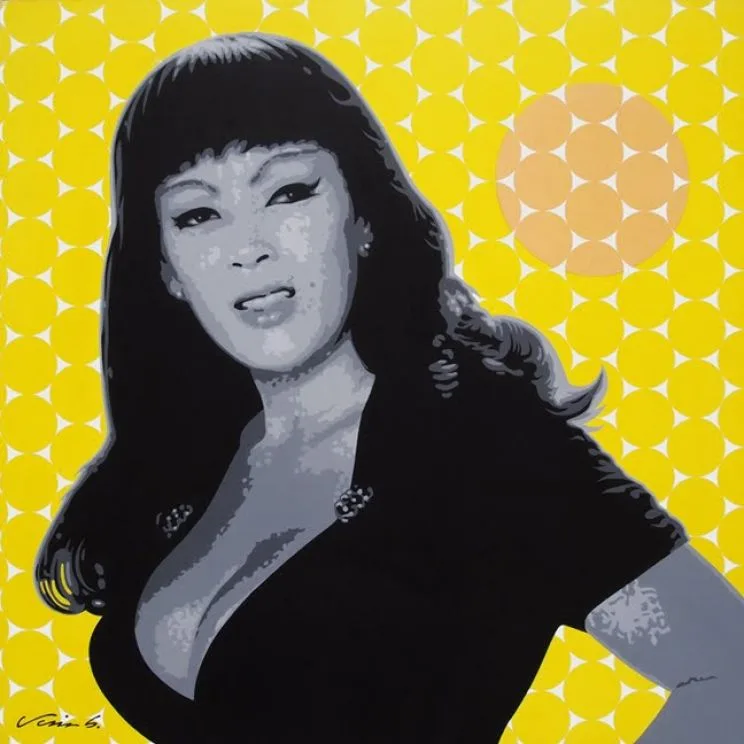Erica Gavin Sexploitation Films in the Golden Age of Cinema
In the wild and turbulent film years between the ‘60s and ’80s, where the boundaries of cinema were constantly being pushed, there was one name synonymous with uninhibited sexuality, social criticism, and especially… large breasts: Russ Meyer. And at the heart of his most iconic works shone an actress who embodied the sexual revolution: Erica Gavin. Born Donna Graff on July 22, 1947, in Los Angeles, California, Gavin became the “poster-girl” for a new era, and her career is inextricably linked to the maverick director and his unique vision.

The Discovery of a Sensation: Vixen! (1968)

The story of Erica’s rise is as unconventional as the films she starred in. While sitting in a dentist’s waiting room in 1968, her eye caught an advertisement in Variety seeking “technically interesting” girls for a new Russ Meyer film. What followed was an audition that would change her life and land her the starring role in the film that made her famous: Vixen!.
Vixen! was not just a film; it was a cultural bomb. It was the first American film to be officially given an ‘X’ rating by the MPAA for mainstream distribution. Meyer’s “satiric sexploitation movie” tackled taboo subjects such as nymphomania, racism, communism, draft dodging, lesbianism, and incest, which was unprecedented in cinema at the time. Critics, including the esteemed Roger Ebert, even praised the film as “the best film to date in that uniquely American genre, the skin flick” and “the quintessential Russ Meyer film”.
Meyer was known for his obsession with “well-endowed, horny women” and “busty and curvy in all the right ways”. Although Gavin might not have been the most extremely voluptuous actress in Meyer’s stable, she fully embraced the role of Vixen Palmer. The film was full of “bare breasts and sweaty sexual encounters” and “plenty of skin of the boozammy kind”. The production was a close-knit team, with Gavin herself helping with various tasks on set, which Meyer described as “summer camp, like a family”. With a budget of only $73,000 (or $68,000), Vixen! grossed over $8 million (or $21 million), and Erica Gavin, with her “fearless portrayal” and “ferocious performance”, instantly became an icon of the sexual revolution.
Erica Gavin & Vincene Wallace- Vixen! (1968)
The Glamorous Chaos of Beyond the Valley of the Dolls (1970)
After the unprecedented success of Vixen!, Erica Gavin reunited with Russ Meyer for the 20th Century Fox production Beyond the Valley of the Dolls (1970). This “pop-art fever dream”, co-written by Roger Ebert, was a satirical look at the chaotic glamour of Hollywood. Gavin played the role of Roxanne, a lesbian fashion designer.
On the set of Dolls, tensions were palpable, and Gavin found herself navigating “on-set tensions, a groundbreaking love scene, and the film’s infamous violence”. Meyer had also cast other “busty” Playmates for the film, such as Cynthia Myers for the role of Casey and Dolly Read as singer Kelly. The film is known for its extravagance and captures a “moment in time in American pop culture”.

Sexploitation: The Undercurrent of Cinema (1960s – 1970s)
Erica Gavin’s career took place in an era when the independent film industry, and particularly “sexploitation” cinema, flourished. These low-budget films were distributed through targeted marketing strategies and screened in specialized venues, including drive-ins. They capitalized on the popular taste for action, adventure, and “titillation”.
The introduction of the MPAA rating system in 1968, with the ‘X’ rating, led to a two-fold development: it paved the way for more adult content and allowed independent producers to differentiate their films. Many independent distributors self-applied the ‘X’ rating without submitting it to the MPAA. Films like Russ Meyer’s were aimed at a youthful, primarily male audience, craving content that differed from mainstream Hollywood productions. Vixen! received the first ‘X’ rating, with Meyer immediately applying it upon the system’s announcement.
After Meyer: New Horizons and Lasting Influence
After her collaboration with Russ Meyer, Erica initially struggled to find suitable roles. But in 1974, she made a memorable return in Caged Heat, Jonathan Demme’s directorial debut. Gavin played Jacqueline Wilson in this cult classic, which was noted for its “feminist take on the women-in-prison genre”. She described Demme as “very relaxed” and more natural than Meyer, which allowed her to bring her own interpretation to the character.
Although Erica Gavin later faded from the spotlight – she struggled with anorexia and worked for years as a stylist without her clients knowing about her film past – her impact on cult cinema has endured. Thanks to recent 4K restorations of the Vixen! trilogy by Severin Films, in collaboration with MoMA, the Academy of Motion Pictures, and the Russ Meyer Charitable Trust, her work is being rediscovered by a new generation of film enthusiasts. Erica Gavin herself has even recorded a new audio commentary for Vixen!, sharing her insights into Meyer’s “fearless filmmaking” and the film’s lasting impact. Her biography, co-written with Steve Sullivan, is also being published by Bear Manor Media.
Erica Gavin remains a fascinating figure in film history, an untamed spirit who pushed the boundaries of cinema in a time of radical change. Her work with Russ Meyer – full of bare breasts, rapid editing, and daring themes – is a crucial part of the era of sexploitation and a lasting reminder of an actress who dared to provoke.

Erica Gavin Overview
Personal Information
- Full Name: Erica Gavin (born Donna Graff)
- Date of Birth: July 22, 1947
- Place of Birth: Los Angeles, California
- Father: Fred Graff (veteran character actor)
- Mother: Madeleine Rosenteil
Background
Erica Gavin grew up in Hollywood and worked as a topless dancer at age 19 at a club called “The Losers,” alongside future colleagues Haji and Tura Satana (both known from “Faster Pussycat! Kill! Kill!”). She discovered an advertisement in Variety for auditions for a new Russ Meyer film while waiting in a dentist’s office.
Complete Filmography

Major Films:
1965 – Red Line 7000
- Director: Howard Hawks
- Genre: Drama / Racing
- Role: Uncredited extra
- Note: Early uncredited appearance before her breakthrough
1968 – The Initiation
- Director: Larry Stewart
- Genre: Slasher / Horror
- Role: Supporting role
- Note: This film is presumed lost.
1968 – Vixen!
- Director: Russ Meyer
- Role: Title role (Vixen)
- Significance: This was her breakthrough film that catapulted her to instant stardom. The film was both a financial and (surprisingly) critical success. It was the first American film to receive an X-rating.
1970 – Beyond the Valley of the Dolls
- Director: Russ Meyer
- Writer: Roger Ebert
- Role: Roxanne
- Studio: 20th Century Fox
- Note: Second collaboration with Russ Meyer
1971 – Erika’s Hot Summer
- Director: Gary Graver
- Genre: Romance / Drama
- Note: A poorly made 16mm softcore film that tried to cash in on Erica Gavin’s fame, offering little beyond her brief, dubbed appearance.
Erica Gavin- Erika’s Hot Summer (1971)
1973 – Godmonster of Indian Flats
- Director: Fredric Hobbs
- Genre: Horror / Science Fiction
- Role: Mariposa
- Note: Obscure cult horror film about a mutant sheep monster
1974 – Caged Heat
- Director: Jonathan Demme
- Genre: Women-in-prison film
- Note: This was one of the early works of future Oscar winner Jonathan Demme
1975 – Ilsa, She Wolf of the SS
- Director: Don Edmonds
- Genre: Exploitation / Horror
- Role: Maigret
- Note: Controversial exploitation film in which Gavin had a supporting role as one of the prisoners
1975 – 3 Stories About Evil
- Director: Harry Novak
- Genre: Horror anthology
- Role: Supporting role
- Note: Obscure anthology film
Magazine Appearances and Publications
Print Media Coverage:
- Glamour Girls Magazine #16 (Spring 2002)
- Cover story titled “Erica Vixen”
- Extensive feature by Steve Sullivan
- Available through her official website
- AV Maniacs Magazine
- Interview by Ian Jane
- Focus on her cult film career
Contemporary Publications and Interviews:
- Featured in various retrospective articles about exploitation cinema
- Subject of academic film studies examining the transition of Hollywood content in the late 1960s
- Regular contributor to cult film festival programs and retrospectives
Modern Media Presence:
- Instagram: @erica.gavin
- Facebook: Official page
- Twitter/X: @EricaGavin
- Official Website: ericagavin.com
Career Highlights and Notable Facts
- Her father Fred Graff was a blacklisted actor during the Hollywood blacklist era
- Considered an icon of “bad girl” cinema from the late 1960s and early 1970s
- Film historians argue she should have become a bigger star than she ultimately became
- Remained active in the cult film community, regularly doing interviews and appearances
- Her work is still celebrated in retrospective screenings, such as recent showings at the Vista Theater in Los Angeles




















